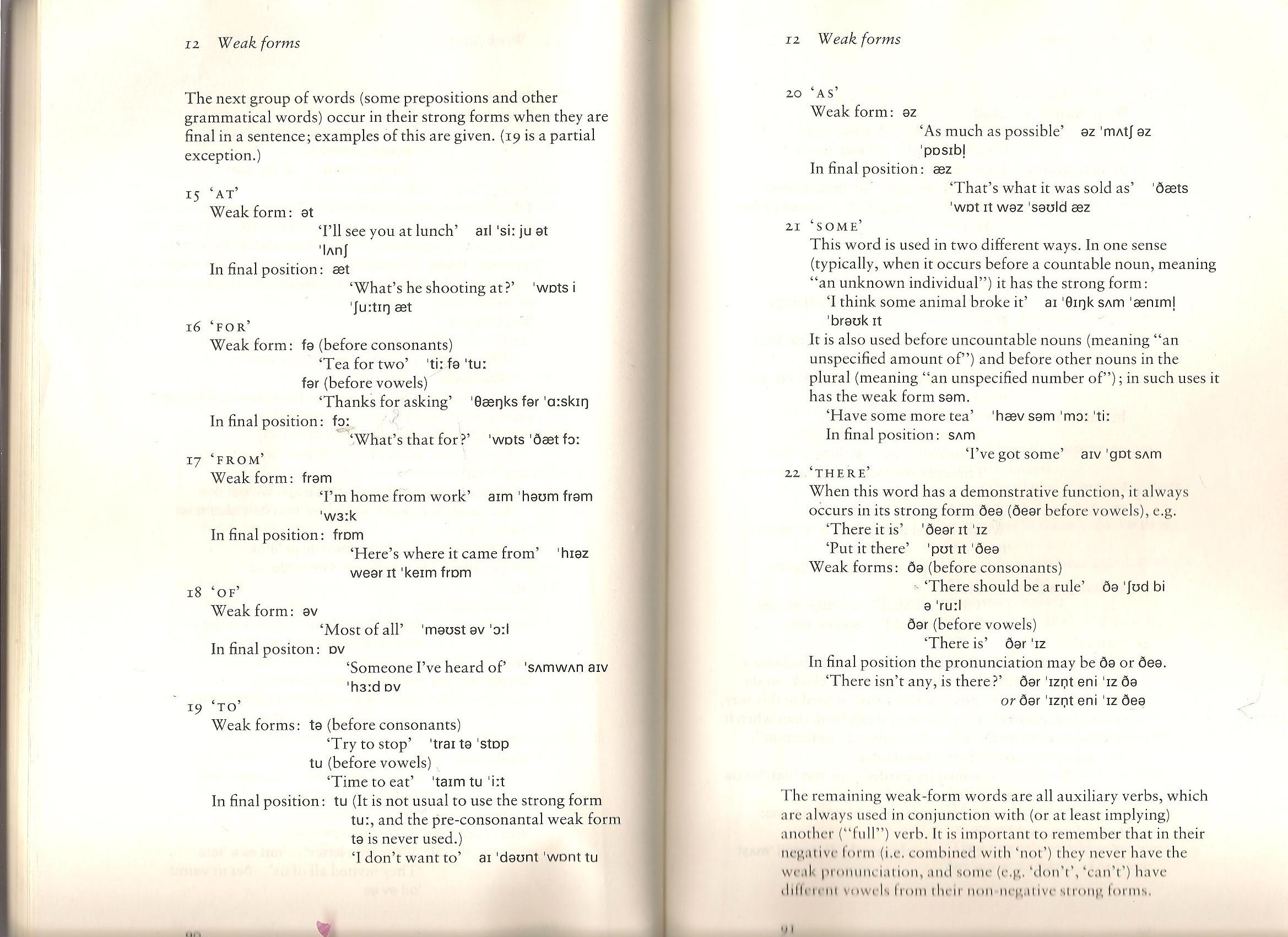roach�2

12 Weak forms
The next group of words (some prepositions and other grammatical words) occur in their strong forms when they are finał in a sentence; examples of this are given. (19 is a partial exception.)
15 ‘at’
Weak form: et
Tli see you at lunch’ ail 'si: ju et ' lAnJ
In finał position: set
‘What’s he shooting at ?’ 1 WDts i
'Juitin set
16 ‘for’
Weak form: fe (before consonants)
‘Teafortwo’ 'ti:fe'tu: fer (before vowels)
‘Thanks for asking’ 'Bserjks fer 'aiskin In finał position: fe:
‘What’s that for ?’ 'wots 'deet fe:
17 ‘from’
Weak form: frem
‘I’m home from work’ aim 'heum frem 'W3lk
In finał position: from
‘Here’s where it came from’ 1 hiez weer it 'keim from
18 ‘of’
Weak form: ev
‘Mostofall’ 'meustev'o:l In finał positon: ov
‘Someone I’ve hearci of’ 'sAmwAn aiv 'h3:d dv
19 ‘to’
Weak forms: te (before consonants)
‘Try to stop’ 'trai te 'stop tu (before vowels)
‘Timetoeat’ 'taim tu 'i:t
In finał position: tu (It is not usual to use the strong form
tu:, and the pre-consonantal weak form te is never used.)
‘I don’t want to’ ai 'deunt 'wont tu
20 ‘AS’
Weak form: 8Z
‘As much as possible’ 8z'mAtj8z
'pDSibl
In finał position: sez
‘That’s what it was sold as’ 'óaets 'WDt It W8Z 'ssold sez
21 ‘SOME’
This word is used in two different ways. In one sense (typically, when it occurs before a countable noun, meaning “an unknown individual”) it has the strong form:
‘I think some animal broke it’ ai 'Girjk SAm 'aemml 'braok it
It is also used before uncountable nouns (meaning “an unspecified amount of”) and before other nouns in the plural (meaning “an unspecified number of”); in such uses it has the weak form ssm.
‘Have some morę tea’ 'haay sam 'mo: 'ti:
In finał position: SAm
‘I’ve got some’ aiv'gotSAm
22 ‘there’
When this word has a demonstrative function, it always occurs in its strong form óea (óear before vowels), e.g. ‘There it is’ 'óe8rit'iz ‘Put it there’ 'pot it 'óea Weak forms: óa (before consonants)
‘There should be a rule’ ós 'Jod bi 8 'ru:l
dar (before vowels)
‘There is’ dar 'iz
In finał position the pronunciation may be da or des. ‘There isn’t any, is there?’ dardzpteni 'izda
or dar 'izpt eni 'iz dea
The remaining weak-form words are all auxiliary verbs, which are always used in conjunction with (or at least implying) anothcr (“luli”) verb. It is important to remember that in their ncgaiivr Innu (i.e. combined willi ‘not’) they never have the w< .il | u ni n ii u iai iotl, a nd some (e.g. ‘douY, ‘ean’i ’) ha vc 111111 n nt \ n\\ i I . 111 mi l In 11 unii i iej',,111 \'( ■ strong I nrms.
Wyszukiwarka
Podobne podstrony:
.4- KIRI Klił Stiral Charta Rf»d aN charts Irom botfcm to top Ch*t* ar« lof hoM h* sha*t. vvfł»o you
roach�1 12 Weak forms 12 Weak forms TU 12, Exs1-4 In the rest of this chapter, the most common weak-
roach 12 Weak forms Chapter 9 discussed the difference between strong and weak syllables in English.
.4- KIRI Klił Stiral Charta Rf»d aN charts Irom botfcm to top Ch*t* ar« lof hoM h* sha*t. vvfł»o you
.4- KIRI Klił Stiral Charta Rf»d aN charts Irom botfcm to top Ch*t* ar« lof hoM h* sha*t. vvfł»o you
cfi r-ł ~ la 1 Nada T^rma ©yron MetcalJ - Mark §££lig - <I>t£V£ Roach
więcej podobnych podstron